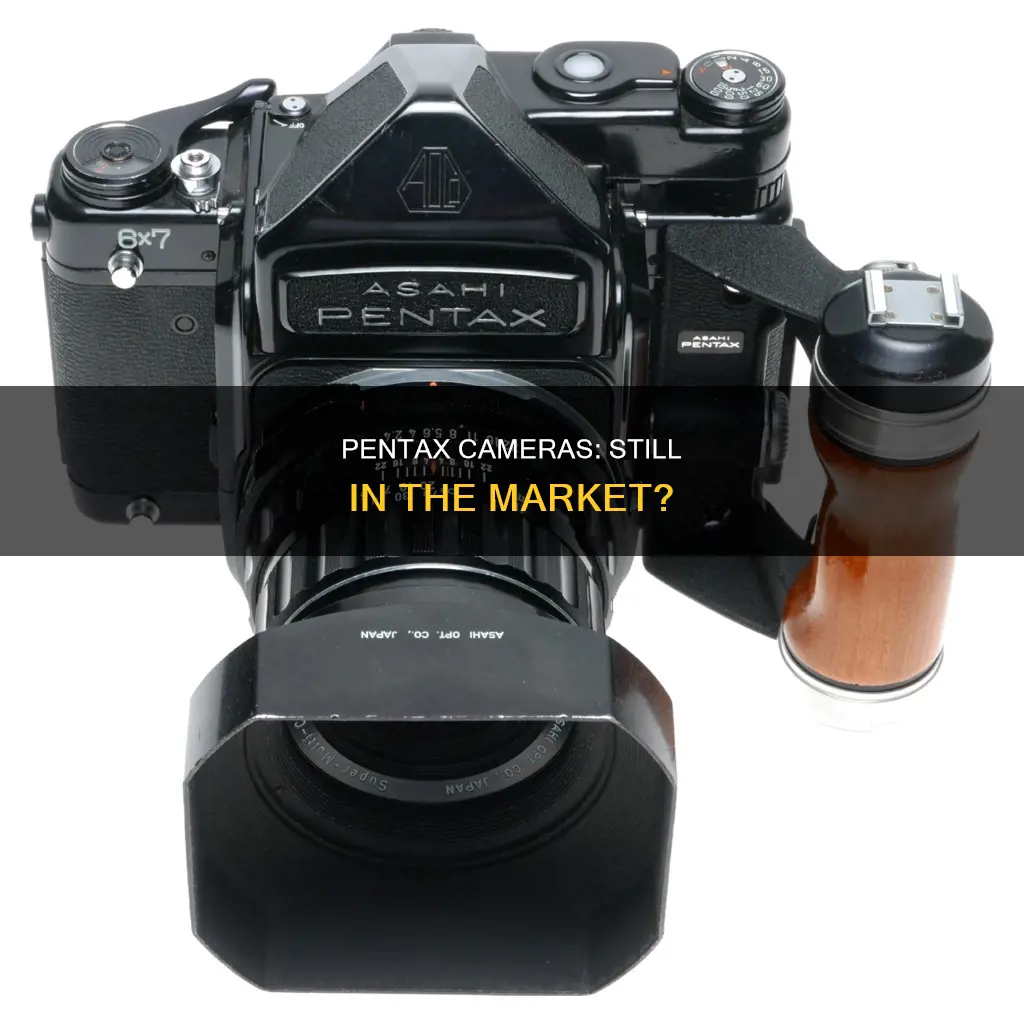
Pentax is a legendary name in the world of stills cameras, with a rich history spanning over a century. The brand has been through several changes in ownership and name, but it remains a well-known and respected manufacturer of optical equipment, including medical devices and binoculars. Despite a decline in market share and various corporate challenges, Pentax continues to innovate and develop new products, particularly in the realm of SLR cameras. With the recent resurgence of interest in film photography, Pentax has launched new film camera projects, aiming to cater to both enthusiasts and younger generations experimenting with 35mm film. The brand's commitment to its traditional stills clientele and unique features, such as weather sealing, has cultivated a dedicated following. Today, Pentax DSLRs are manufactured in Cebu, Philippines, while digital Pentax lenses are produced in Hanoi, Vietnam, under Pentax Ricoh Imaging Products.
What You'll Learn

Pentax's new film camera project
Pentax, the legendary camera manufacturer, has had a rich history since its founding in 1919. In June 2024, Pentax launched the Pentax 17, a half-frame film camera, marking its first film camera release in over two decades. This launch is part of Pentax's new film camera project, which aims to develop a series of new film camera products.
The project, initiated by Pentax's parent company, Ricoh, involves researching and developing new Pentax-brand film cameras to cater to the growing interest in film photography, especially among younger generations. Ricoh Product Planner, Takeo Suzuki, outlined the roadmap for the film camera project, starting with a compact film camera and progressing to a high-end compact model, an SLR model, and ultimately, a fully mechanical SLR camera.
The project addresses the challenges of restarting film camera production and aims to make owning film cameras more accessible and smoother, including after-sales service. Pentax's heritage in film camera innovation, dating back to the 1950s, positions it well to cater to the resurgence in film photography.
Pentax's commitment to innovation and its pioneering role in SLR cameras are key aspects of this new film camera project. The project intends to build upon Pentax's history of delivering high-performance imaging products, combining cutting-edge technology with affordability.
The new film camera project showcases Pentax's dedication to its traditional stills clientele and its recognition of the enduring appeal of retro technology. By focusing on optical viewfinders and DSLR cameras, Pentax sets itself apart from competitors and caters to dedicated hobbyists who appreciate the tactile joys of 35mm film.
Is Your Eufy Camera Charging? Check This Way
You may want to see also

Ricoh's subsidiary
Pentax cameras are still being made, but not by the Pentax Corporation. In 2011, Hoya—which had acquired Pentax in 2007—spun off the Pentax brand's digital camera business, which was then acquired by Ricoh. This led to the establishment of Pentax Ricoh Imaging, which was renamed Ricoh Imaging Company Ltd in 2013.
Ricoh continues to develop and market digital cameras under the Pentax brand. Pentax DSLRs are manufactured in Cebu, Philippines, while digital Pentax lenses are manufactured in Hanoi, Vietnam, under Pentax Ricoh Imaging Products.
Ricoh's acquisition of Pentax's camera division came after Pentax navigated a few corporate culs-de-sac and a deal with another optical company, Hoya, in the mid-2000s. Hoya closed Pentax's Tokyo factory, which was likely a difficult blow for the company, as it had kept Japanese manufacturing facilities in continuous operation since the 1930s.
Ricoh seems keen to continue using the Pentax brand on certain products, although losing the name from the company's official title has been considered a shame by some. Pentax DSLRs, such as the K-1, have performed well in comparisons, particularly due to their affordability and features like weather sealing.
In 2024, Pentax launched the Pentax 17, a half-frame film camera, marking the company's first film camera release in over two decades. This launch was a response to the growing interest in film photography. Ricoh has also launched a new 'Film Camera Project', which involves the research and development of new Pentax-brand film camera products.
Baby Camera Cloud Storage: Charging for Your Dog's Memories?
You may want to see also

Pentax DSLRs
In 2006, Pentax's domestic market share in digital cameras had declined to 4%. The company was acquired by Hoya in 2007 and subsequently merged with them the following year. In 2011, Hoya spun off Pentax's digital camera business, which was then acquired by Ricoh, leading to the establishment of Pentax Ricoh Imaging.
Despite these changes, Pentax continued to develop and market DSLRs. Their DSLRs offer a blend of exceptional photography and video recording, catering to both beginners and hobbyists with simple-to-use interfaces, as well as advanced features for more experienced photographers.
Some popular Pentax DSLRs include the K-3 Mark III, the K-1 Mark II, and the K-70, which come in various kits with different lenses and accessories. These cameras offer features such as high megapixel counts, full-frame sensors, and tiltable LCD screens.
In addition to their DSLRs, Pentax has also released mirrorless interchangeable-lens cameras, such as the Pentax Q range, and has partnered with other companies like Samsung to develop new DSLR models.
While Pentax's market share may have declined in the past, they continue to be a recognised brand in the camera industry, with a dedicated customer base that appreciates their history and unique features.
Understanding ISO Mode in Photography
You may want to see also

Pentax's history
Pentax, originally founded as Asahi Optical Joint Stock Co. in 1919, started as a manufacturer of lenses for eyeglasses. The company was founded by Kumao Kajiwara in a shop in the Toshima suburb of Tokyo. In 1938, the company changed its name to Asahi Optical Co., Ltd. and began manufacturing camera and cine lenses. During World War II, Asahi Optical devoted its time to fulfilling military contracts for optical instruments.
After the war, the company was disbanded by the occupying powers and was allowed to reform in 1948. Asahi Optical resumed its pre-war activities, manufacturing binoculars and consumer camera lenses for Konishiroku and Chiyoda Kōgaku Seikō (later Konica and Minolta, respectively). In 1952, Asahi Optical introduced its first camera, the Asahiflex, Japan's first single-lens reflex camera. The name "Pentax" was acquired by the company in 1957 from the East German VEB Zeiss Ikon and the company became primarily known for its photographic products.
In 1969, Pentax began distributing 35mm equipment under the name "Asahi Pentax" and medium-format 120 6x7cm equipment under the sub-brand "Pentax 6x7". In 1990, the sub-brand was renamed to "Pentax 67" and the company continued to produce these cameras until 1999. In 2002, the Asahi Optical Co. Ltd. officially became Pentax Corporation.
In 2006, Pentax started the process of merging with Hoya Corporation to form 'Hoya Pentax HD Corporation'. However, it was speculated that Pentax's camera business could be sold off after the merger. On August 6, 2007, Hoya completed a friendly public tender offer for Pentax and acquired 90.59% of the company. In 2011, Hoya spun off the Pentax brand's digital camera business, which was then acquired by Ricoh, leading to the establishment of Pentax Ricoh Imaging. In 2013, the company name was changed to Ricoh Imaging Company Ltd.
Ricoh continues to develop and market digital cameras under the Pentax brand, with Pentax DSLRs being manufactured in Cebu, Philippines, and digital Pentax lenses being made in Hanoi, Vietnam. In June 2024, Pentax launched the Pentax 17, a half-frame film camera, marking the company's first film camera in over two decades.
Olympus Cameras: Still in Production or a Thing of Past?
You may want to see also

Pentax's competitors
In 2005, Pentax Corporation partnered with Samsung to collaborate on camera technology and better compete with Nikon and Canon. Pentax's other competitors include Olympus, Sony, Sangi, and Kyocera.
Pentax Medical, a division of Hoya Group, also has several competitors in the medical equipment space. These include Vivitar, Leica, TAMRON Co., Sigma, Teledyne DALSA, Analogic, I-MED Network Radiology, and FUJIFILM SonoSite.
Updating Lightroom: Fix Camera Raw with Simple Steps
You may want to see also
Frequently asked questions
Yes, Pentax cameras are still being made. The company was acquired by Ricoh in 2011 and operates under the name Pentax Ricoh Imaging Company, Ltd.
Pentax is known for its DSLR cameras, which are popular among photographers for their affordability and features such as weather sealing. The company has also released mirrorless interchangeable-lens cameras in the past.
Pentax was founded in 1919 as a workshop specialising in polishing eyeglass lenses. The company developed Japan's first single-lens reflex camera, the Asahiflex, in 1952. Over the years, Pentax has gone through several acquisitions and name changes, but it remains a well-known brand in the photography industry.







